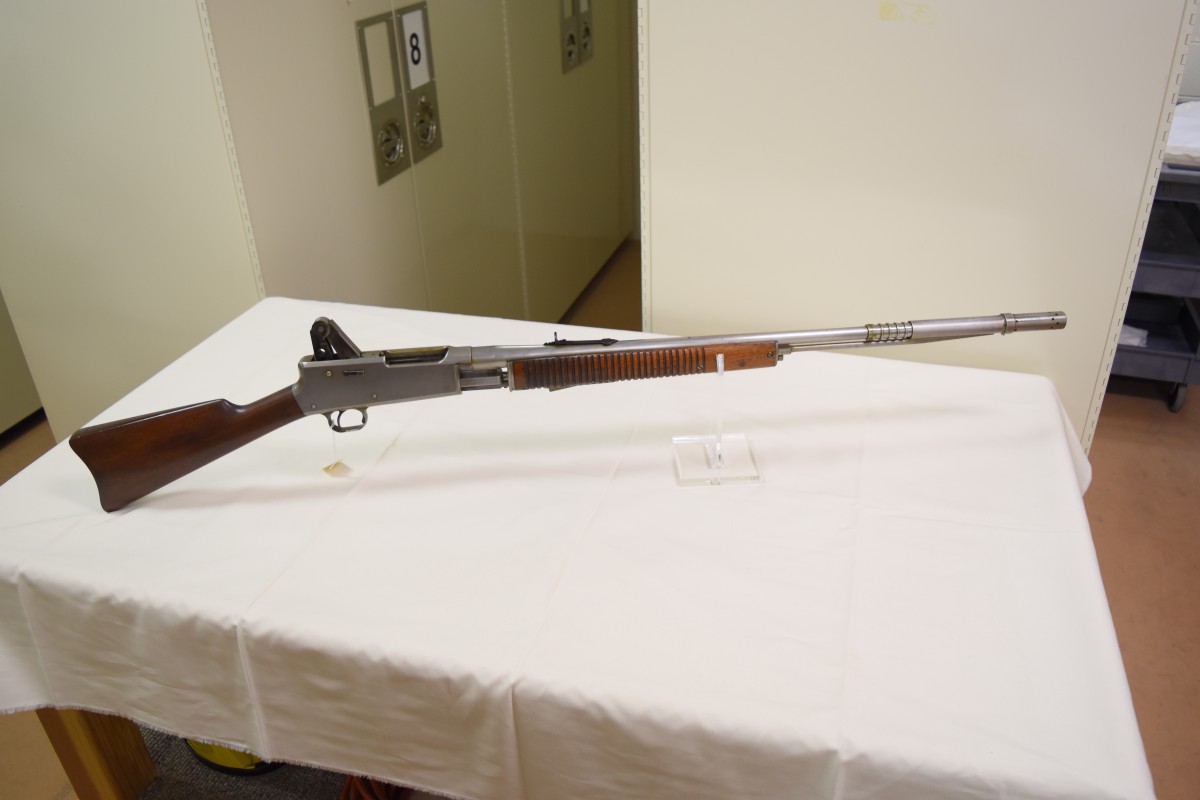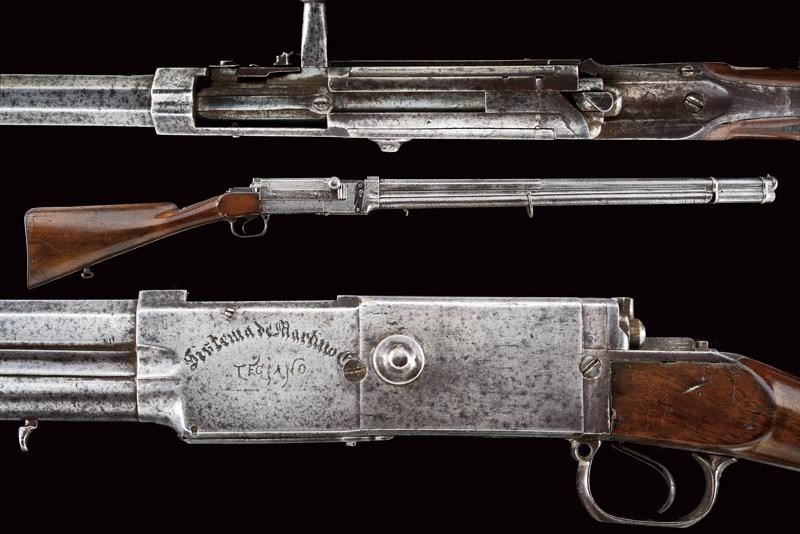 . Daniel B. Wesson Patent Prototype Slide Action.
. Daniel B. Wesson Patent Prototype Slide Action.  . [
. [
Winchester Prototype .410 Slide Action Shotgun
](Kennisgeving voor omleiding).  . [
. [
Very Rare Burgess Prototype Slide Action Rifle
](Kennisgeving voor omleiding)  .
.  .
. 



Owen Jones Rifle
The Martini-Henry Rifle entered service with the British Army in 1871. While the fast-loading breech loader was a step forward, small arms technology quickly advanced and by the 1880s magazine-fed weapons were beginning to dominate the battlefield.
In February 1883, the British War Office formed a new Small Arms Committee to find and evaluate new magazine rifle designs. Designer made a number of attempts to convert the existing Martini-Henry into a magazine weapon. The committee selected a system developed by Owen Jones, of Philadelphia, for testing against James Paris Lee’s magazine-rifle and a Lee rifle outfitted with a Burton magazine. All three of the weapons chambered the new .402 calibre rimmed Martini-Enfield cartridge and had barrels with 7-groove rifling developed by William Metford.
Jones had already had some success when his 1878 revolver patent became the basis for the .476 calibre Enfield Revolver, adopted by the British military in 1880. Of the three rifles tested Jones’ rifle was the only one to attempt to adapt the Martini-Henry. The British patent office granted Jones a patent protecting the first iteration of his system in 1883. The Martini-Henry’s design made it extremely difficult to adapt. Jones’ first design had an ingenious elevator system which replaced the Martini-Henry’s lever with a slide. Image #1 shows an early version of his rifle with a large wooden knob on the right side of the receiver. The knob cycled the action while a thumb trigger fired the rifle. The elevator brought cartridges from a magazine located in the butt up into the action (see image #4). Between 1884 and 1885 Royal Small Arms Factory at Enfield built several improved versions of the rifle. The first of these relocated the slide to the underside of the butt and added a cut-off lever and safety. The initial tests with the Jones rifle showed that its slide-action made its rapid fire capabilities superior to those of the Lee action rifles.

All 4 types of Owen Jones’ rifle (from The Lee Enfield Story, Skennerton)
While the magazine type and location varied depending on prototype the feature which remained constant was the sliding action. Some dispensed with the traditional trigger and instead had a thumb trigger. A later, less ambitious simplification of the design developed in 1885, had a 5-round hopper magazine mounted on the right side of the receiver but retained the operating slide. Jones panted this iteration of the design in January 1886. The Royal Navy became interested in the design and ordered 100 rifles for independent trials. For some reason this number was increased to 5,000 for immediate adoption. The final version of the Owen Jones rifle also had the side mounted hopper magazine which the rifleman raised manually to load each new cartridge. This allowed the round to roll into the action through an aperture in the receiver - this dispensed with the need for a cut-off switch. During trials the Owen Jones rifle came first in a six round rapid fire test against the Martini-Henry, Lee rifle and a Lee with a Bethel-Burton magazine. The Owen Jones rifle fired six rounds from its magazine in 4.8 seconds while the Martini-Henry fired the same in 12.5 seconds. In a Mad Minute-like test the Owen Jones managed to fire 29 rounds to the Martini-Henry’s 27.
Colonel H. T. Arbuthnot, the superintendent of the Royal Small Arms Factory, objected to the adoption or manufacture of the Jones Rifle on the grounds that it was much too complicated and too fragile for service. As a result troop trials with the Lee rifle and Jones began in October 1886 and tests at HMS Excellent, the naval gunnery school, found the Jones to be jam prone, fragile and overly complex.
The complex Jones system initially had 121 parts, however, by 1885 this was reduced to 113 with the system’s simplification. Given the design’s complexity it is unsurprising that Arbuthnot objected. The Small Arms Committee dropped the Jones rifle from contention by late 1886. The committee selected the Lee rifle in December 1888, it was later adopted as the .303 Lee-Metford, Magazine Rifle, Mark I. Perhaps just over 100 Owen Jones Rifles were made. Today the Royal Armouries’ collection holds five examples of various pattern Jones rifles.  .
. 
 . Rara pistola ad ago
. Rara pistola ad ago  .
.  . [
. [. [
 . John Browning’s 1895 Slide Action Rifle Prototype.
. John Browning’s 1895 Slide Action Rifle Prototype. .
 . Belgian-Mauser-Model-89.
. Belgian-Mauser-Model-89.  .
.  . [Springfield Armory 1901 Experimental Bolt Action Rifle
. [Springfield Armory 1901 Experimental Bolt Action Rifle . Prototype U.S. Springfield 1903 Semi-Automatic Conversion.
 . Swiss Schmidt Rubin PROTOTYPE K1889 Rifle.
. Swiss Schmidt Rubin PROTOTYPE K1889 Rifle.  . STANDARD ARMS CO MODEL “M” SLIDE ACTION RIFLE .30
. STANDARD ARMS CO MODEL “M” SLIDE ACTION RIFLE .30
 . STANDARD ARMS CO MODEL “G” SLIDE ACTION RIFLE
. STANDARD ARMS CO MODEL “G” SLIDE ACTION RIFLE  . Winchester 1890 Prototype Magazine Lever Action Rifle, Circa 1906.
. Winchester 1890 Prototype Magazine Lever Action Rifle, Circa 1906.  . [
. [ . JMB Prototype and Production 1895.
. JMB Prototype and Production 1895.  . Netsch automatic carbine
. Netsch automatic carbine .
. 
 . [
. [ 7MM M1893 EXPERIMENTAL/PROTOTYPE RIFLE. Prototype Smith-Condit/Standard Arms Bolt Action Semi-Automatic Rifle
7MM M1893 EXPERIMENTAL/PROTOTYPE RIFLE. Prototype Smith-Condit/Standard Arms Bolt Action Semi-Automatic Rifle  .
. 
 . Model 1892 Short Rifle
. Model 1892 Short Rifle
 . Daniel B. Wesson Patent Prototype Slide Action.
. Daniel B. Wesson Patent Prototype Slide Action.  . [
. [ . [
. [ .
. 




 .
. 